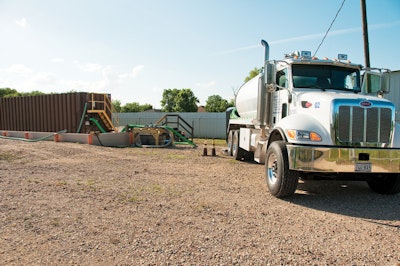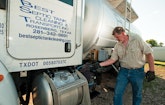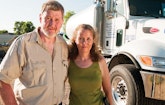Interested in Onsite Systems?
Get Onsite Systems articles, news and videos right in your inbox! Sign up now.
Onsite Systems + Get AlertsLike many couples running small septic service outfits, Brad and Kim Heath of Best Septic Tank Cleaning and Transport Inc. in Rosenberg, Texas, have come to a realization over the years: Staying small has its rewards. So does emphasizing customer service and sticking with what you do best.
Armed with this less-is-more approach and Brad Heath’s resourcefulness and problem-solving skills, the couple prefer to go it alone, operating without employees — even though they have more work than they can handle. They run a lean, scaled-down business that enables them to better control service quality and stay closely attuned to customers.
“If we keep it simple, we can stay on top of quality assurance,” Heath says. “This way, I know work will be done to my satisfaction.”
Heath upholds the high standards his father, Neil Heath, established when he founded the company in 1981. He named the company Best Septic because he always wanted to be the best at what he did, Heath says. While the name invites critique, Heath says he doesn’t feel any pressure because the be-the-best mentality is such an integral part of daily operations. He says it’s easier to stay focused because Best does only what it does, well, best: Clean septic tanks.
“We specialize in cleaning, not doing repairs or installations,” Heath says. “We have enough business just cleaning septic systems.”
Hard work is nothing new to the Heaths. After graduating from high school, Heath worked part time for his father, while also holding down a part-time job as a journeyman electrician at a local power plant. Kim Heath worked for almost 10 years as a registered nurse at a Houston hospital before coming aboard at Best. Their son, Chris, also worked during summers from junior high school on, and was a full-time employee from 2005 until this summer, when he joined the military.
In 1996, Heath took advantage of an early-retirement buyout offer from the power plant and went to work full time with his father, who passed away four years later. At that point, the Heaths assumed control of the company, with Kim handling office and administrative duties and Brad handling the fieldwork.
OPERATIONAL OBSTACLE
Heath’s problem-solving mettle was tested soon after when state officials challenged the viability of two 7,700-gallon, underground fiberglass storage tanks the company used as a transfer station. Heath’s father installed the dual-wall tanks in the early 1990s to hold waste until it could be hauled away. The nearest waste-disposal facilities are on the other (east) side of Houston, a 2-1/2-hour drive, or in Abilene, some 500 miles away.
Local health department officials had never expressed concern about the tanks, not even when Heath played it safe and submitted pictures and technical details about them. “They came around and gave us great marks … we thought we were in good standing with everyone,” he says.
But when new regulations prompted a state agency to review old waste-storage sites, Heath was told the tanks would have to be situated above ground — a potential financial back-breaker. That’s where Heath’s resourceful streak kicked into gear.
He started by designing a fractional 21,000-gallon storage tank, which basically is a storage tank with a compartment on one end that separates large debris, leaving cleaner sludge. He added a reinforced concrete wall around the tank to contain potential leaks.
“I contract with a waste hauling firm to come twice or three times a week with waste transport trucks and take the waste to a tank farm about 18 miles away,” Heath explains. “There, it’s processed with a lime slurry for 24 hours, and after it stabilizes, is land-applied in pastures. When I have time and it makes sense geographically, I take waste there myself because I can save several hundred dollars a trip.”
It took two years to get a site-operation plan approved. Then it took eight months to build the facility. The cost? About $60,000 for the tank, $7,000 for chain-link fencing and another $30,000 or so for concrete work.
“It works perfectly,” Heath says. “I designed it myself and built it to what I needed. It would’ve cost two to three times that much to have someone else design and build it.”
In the wake of that experience, Heath has some advice for other pumpers in the same situation: Ask regulatory officials very precise questions and obtain very specific answers.
“You don’t want anything vague,” he says. “You have to understand the rules and be certain that the way you’re building it is acceptable, because you don’t get a second chance financially to do it right. And don’t accept verbal agreements. Always insist on a written understanding or agreement.”
NEW RULES BOOST BUSINESS
On the other side of the coin, Best Septic benefits from another new regulation that requires homeowners to replace failed septic systems with aerobic systems. Heath estimates that about half the systems in the county are conventional gravity-fed systems, while the other half are aerobic systems.
Aerobic systems require more frequent cleanings because the waste compartment is smaller — about 400 or 500 gallons — and there’s no separation of grey and black water. All the waste material drains into the first primary waste compartment, so bacteria don’t work as quickly because things like grease, soap and food mix with the waste.
A new state law requires a licensed maintenance company to perform quarterly inspections of aerobic systems to be sure they’re functioning properly, Heath says. Maintenance companies then refer cleaning jobs to pumpers like Heath.
Because new systems are expensive to install, Heath tries to educate customers about proper septic system care so their existing systems last longer and stave off expensive replacement as long as possible.
“We came up with a maintenance tip sheet with suggestions to help prevent problems, and another sheet that explains how conventional and aerobic systems work,” Heath says. “I tell them what kinds of soap and papers work best and which chemicals are detrimental to bacteria, like bleach or harsh cleaning chemicals. We try to get them to use citrus alternatives, which aren’t as harsh on septic systems. We also try to get them to buy into preventive maintenance.”
Heath believes patiently talking to customers and answering their questions builds trust. Plus, he says the better customers understand their systems, the easier it is to clean them.
“It’s important to me that customers understand how a system works, so they can save money,” Heath says. “That’s the way my father did it, and that’s how I do it, too. It helps build customer loyalty. Some people will wait two or three days just so we can pump their tank, instead of using a competitor. They’re very loyal because of the rapport we’ve built. About 50 percent of our total business comes from word-of-mouth referrals.”
GOOD EQUIPMENT A MUST
To service customers, Heath relies on a 1997 Chevrolet C6500 equipped with a 1,900-gallon aluminum tank and Masport pump; and a 2007 Peterbilt 335 outfitted with a 4,000-gallon aluminum tank built by Pik Rite Inc. and Masport pump.
Given the dearth of nearby waste-disposal sites, the Peterbilt truck with its sizable tank was a game-changer for Best. (Kim Heath was so excited about the purchase that she obtained a commercial driver’s license so she could drive the truck, too.)
“By buying such a large truck, I can use it as a vacuum truck and a transport truck,” Heath says. “I can pump two or three residential tanks at a time, which actually allowed me to drop my (per-gallon hauling) rate when most guys are having a hard time not raising their rates — and still recognize a good profit margin because I’m not wasting time,” he explains. “Now I can get more jobs done in a given day because I don’t have to drive as much … and I pass those savings down to my customer. When I tell them their rate went down, they just look at me in disbelief.”
Heath also saves his customers money by trying to schedule tank cleanings during dry spells, so there’s less liquid waste to haul. In hot, dry Texas, the savings can be significant. To build trust with customers, Heath always shows them the (tank) gauge before and after pumping.
“We don’t charge a flat fee because the number of gallons pumped fluctuates,” he says. “Some of our customers have been with us for two or three generations … we’ve earned that trust. That’s worth a lot more than money. Money isn’t everything. I always try to put myself in my customers’ shoes and save them money.”
NO CHANGES IN SIGHT
Looking ahead, Heath doesn’t see many changes in the offing. In the long term, Kim Heath plans to finish a degree in culinary management in fall 2012, then hopes to split her time between running Best and managing a restaurant at night.
Until then, Heath says they are content to wear the many different job hats required to run the company with about 7,000 accounts. When there’s too much work for Heath to handle, he refers business to two other family-owned companies whose owners he knows and work ethics he respects.
“She’s the president, general manager and accountant, and I’m vice president, plant superintendent, field supervisor and head of maintenance,” Heath quips about the couple’s many job titles. “I can make more money doing jobs myself and putting in a little more time, and I’m happy where my business is going and doing things to my and my customers’ satisfaction.”










